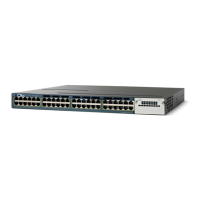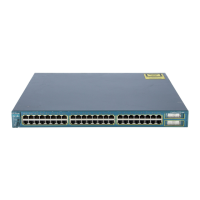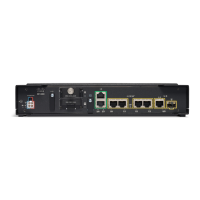1-34
Catalyst 3750-X and 3560-X Switch Software Configuration Guide
OL-25303-03
Chapter 1 Configuring QoS
Configuring Auto-QoS
Auto-QoS VoIP Considerations
• Auto-QoS configures the switch for VoIP with Cisco IP Phones on nonrouted and routed ports.
Auto-QoS also configures the switch for VoIP with devices running the Cisco SoftPhone
application.
Note When a device running Cisco SoftPhone is connected to a nonrouted or routed port, the
switch supports only one Cisco SoftPhone application per port.
• When enabling auto-QoS with a Cisco IP Phone on a routed port, you must assign a static IP address
to the IP phone.
• This release supports only Cisco IP SoftPhone Version 1.3(3) or later.
• Connected devices must use Cisco Call Manager Version 4 or later.
• Auto-Qos VoIP uses the priority-queue interface configuration command for an egress interface.
You can also configure a policy-map and trust device on the same interface for Cisco IP phones.
Auto-QoS Enhanced Considerations
• The auto qos srnd4 global configuration command is generated as a result of enhanced auto-QoS
configuration.
• If the legacy auto qos voip commands are executed on the switch and the mls qos command is
disabled, the enhanced auto-QoS configuration is generated. Otherwise, legacy auto-QoS commands
are executed.
Enabling Auto-QoS
For optimum QoS performance, enable auto-QoS on all the devices in your network.
Beginning in privileged EXEC mode, follow these steps to enable auto-QoS devices within a QoS
domain:
Command Purpose
Step 1
configure terminal Enter global configuration mode.
Step 2
interface interface-id Specify the port that is connected to a video device or the uplink port
that is connected to another trusted switch or router in the network
interior, and enter interface configuration mode.
Step 3
auto qos voip {cisco-phone |
cisco-softphone | trust}
or
Enable auto-QoS.
• cisco-phone—If the port is connected to a Cisco IP Phone, the
QoS labels of incoming packets are trusted only when the
telephone is detected.
• cisco-softphone—The port is connected to device running the
Cisco SoftPhone feature.
• trust—The uplink port is connected to a trusted switch or router,
and the VoIP traffic classification in the ingress packet is trusted.

